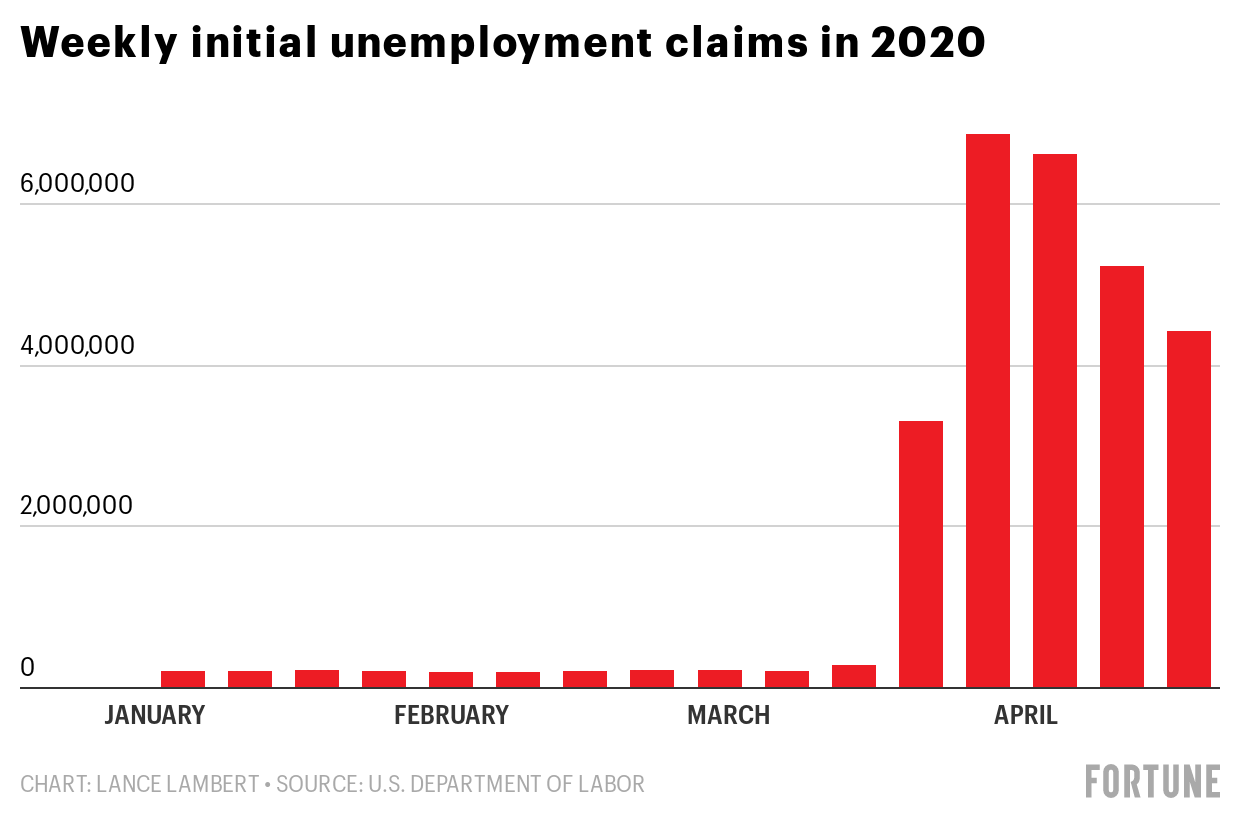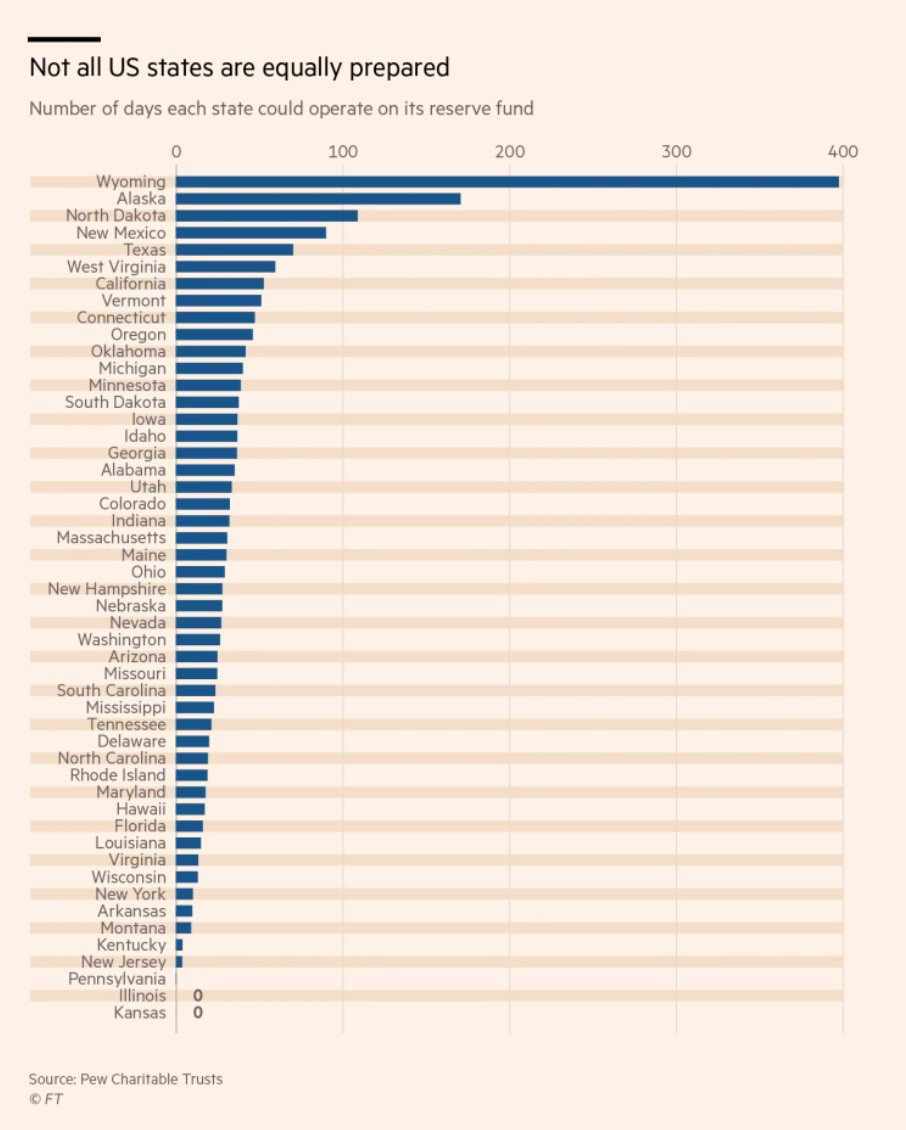Startup Offense and Defense in the Recession
Multiple economic indicators suggests the economy is getting worse. Like Wiley Coyote suspended in mid-air and not yet realizing he is about to plummet to the ground, the US economy is magically suspended by wishful thinking and unsustainable monetary policies.

^Current image of the US Economy (source: US Fed)
A number of economic measures to give a sense of the situation.
Unemployment claims at all time highs:

Retail sales down dramatically.

Factory output down to lowest levels since post-WW2.

Restaurants in a mass shut down. OpenTable data for restaurants.

Hospital systems are losing large amounts of money due to a lack of elective procedures.
Revenue at many non-profit hospitals has fallen 50% or more in the last few weeks.
Cities and municipalities are heading towards large budget deficits due to drop in tax receipts.

China data does not lend much comfort to a fast recovery. Production is down 10% and consumer demand is down 30%, despite China "unlocking". China is still grinding back to baseline and has a long way to go. We should expect the same of the US economy.

Economic shocks and cascades
It usually takes 3 to 6 months for an economic shock to wend its way through the economy. Like dominos slowing falling over there is a cascade of hiring freezes, purchasing freezes and layoffs. The companies whose customers did purchasing freezes or cost cuts suddenly find their own revenue dropping, so they too need to decrease costs in headcount and/or purchasing.
Right now big enterprises have been going through the following steps:
1. Figure out this COVID thing. (1-2 weeks)
2. Figure out how to get 10,000 people to work from home and become somewhat productive. (4 weeks)
3. Figure out impact of economic slowdown to our business and customers (2-4 weeks)
4. Decide how to cut costs and pull together layoff plan (4 weeks)
5. Take action like layoffs, IT buying freeze etc. (4-8 weeks)
In other words, it should take a large enterprise 3-6 months to move to remote work, understand its financial situation, plan a layoff and buying freeze, and execute it. Given that we are only a month or two into COVID, much of the damage is yet to come. This means many startups won't see the real impact of the slow down for anywhere between a few weeks and two quarters as big enterprises figure it all out and then act.
As more people become unemployed (many economists estimate 20-30% unemployment) and consumer demand drops, more large enterprises will take the following actions:
1. Slow or freeze purchasing
2. Renegotiate prices or contracts & backend payments
3. Freeze hiring or do layoffs
4. Divest assets or divisions
5. Some will also be aggressive and start doing more M&A or market consolidation
As a startup you will need to make a series of offensive and defensive moves to deal with this new environment.
If you are an early stage company that has raised 2-3 years of cash, you may be fine and can ignore a lot of the advice below. Your focus should be on building a team and product that will get to product/market fit in today's environment. The main suggestion would be to focus on a product that can sell in a year when your product is ready - the biggest risk for an early stage company is that sales cycles may take longer.
For everyone else, read on :)
Defensive Moves
1. Check your cash burn.
Assess your situation:
How much cash do you have?
What is happening to your business?
What is likely to happen given customer mix?
You need to figure out how to get to 2 to 3 years of cash. 3 is optimal as it gives you:
6-12 months for the economy to bottom
6-12 months to adjust and start to grow again. You will need to show growth to fundraise at a good price.
9-12 months of buffer when you go out to fundraise
Getting to 2-3 years may include fundraising, pricing or payment changes with customers, or cutting your own costs via layoffs or other means.
In planning burn you should assume also do a "stress test" model. For example, if you planned to grow 3X this year, what happens if you grow 2X? If you are flat with the year? If you are down 50%? Some businesses are actually accelerating out of COVID and this might not be relevant. If you are already seeing things slow you might want to see what a low probability, worst case plan means for cash management as the economic picture unfolds during the next 2 quarters.
2. Raising money in a recession.
There is an old saying in fundraising "when they are passing the hors d'oeuvres take two" - when money is available you should take it. Fundraising in a recession is different from fundraising in good times.
Optimize for an OK valuation and speed versus a great valuation and slow process. Valuations that look cheap in a given moment may look expensive 6 months later during volatile times. In good times you should optimize for valuation. In bad times, you should optimize for speed, simplicity, and buffer.
Take a bit of extra money. Make sure that in your very worst case you can have 3 years of cash or bridge to profitability. A little extra dilution in a recession is better than uncertainty on multiples or cash position in the future.
Remember that getting profitable gives you more options than not. The lower your burn, the higher your leverage all else being equal.
Expect more inside rounds. Many VCs are focusing first on their own portfolio in terms of funding, and then will look externally in a few months. Expect many of the rounds in the next few months to be driven by insiders. In some cases these will be reopenings of prior rounds.
Pricing uncertainty. VCs are struggling with how bad businesses will be impact due to the recession. Given that the next 3-6 months are highly uncertain VCs do not know what valuation to give. Will the business still grow its projected 300% this year or will it growth 50%? Enterprise sales deals from last year are closing in April, but will new sales deals initiated remotely last month close or stay open longer? Given the business uncertainty many VCs are having trouble giving offers, making fundraising harder.
May and June are likely to be months of relative optimism. The stock markets are resilient. Lockups are coming off. The sun is out. Big promises are being made on vaccines and drugs (without data to support them yet). The economic carnage has not been highlighted by media much yet. The next 2 months may be a relatively good time to fundraise.

3. Understand which customers are at risk, and which should be embraced.
If you sell to enterprises, go through your customer list. If you have revenue concentration, look at your top N accounts. Do you have travel, local governments, retail, real estate, or other customers? If so, which are high risk of cancelation or renegotiation? You can discount this revenue as you plan for burn. You may need to fire bad customers, or stop extending credit.
Which customers also seem to be accelerating or doing better in this time? You may want to spend more time with them or focus your sales efforts on upselling your most stable customers or getting your product prepaid.
If you do not have high revenue concentration, you can instead look at vertical views. What % of your business is exposed to travel, DTC, offline retail, restaurants or other segments? This will allow you to predict customer churn or models and understand runway. You may also want to cut marketing or inside sales to verticals that are likely to churn and reallocate spend to verticals that will be stable or grow.
4. Plan for hiring freezes or layoffs.
Although it takes time to build a recruiting pipeline, when in doubt you may want to freeze hiring and wait to see the impact the recession will have on your business. If you think there is some chance you will need to do a layoff, plan it in advance. It often takes some time to execute and you want to do it well, both for the people leaving as well as the employees who stay behind.
The key tenets of a layoff include:
Have a crisp plan and process.
Treat people well.
Create stability for the people who are still with the company. This layoff's goal is to save their jobs and save the company, not remove other people's jobs.
Cut deeper than you ever think you will need to. It is much worse to do multiple sequential layoffs than a single deep cut. You can always rehire people if you cut too much, but it is tough and hurts the culture to do multiple rounds.
When I moved out to Silicon Valley I joined a high flying startup backed by Sequoia and Matrix. The company grew from 120 to 150 people, and then shrank to ~12 people over 5 rounds of lay offs as the internet bubble imploded. I got laid off in the 3rd round. It would have been better for the company to do one big cut up front and preserve cash than to wait through multiple layoffs and keep burning large sums of money. Repeated layoffs devastated moral at the company.
A16Z has a good guide to planning layoffs here.
5. Build culture and create stability for employees
While many founders thrive on unpredictability, most employees crave stability. Particularly in times like these it is important for people to feel safe and secure. Employee stability may include create and communicating the following:
Financial stability of the company. Explain cash position, customers, and how the company is going to bridge the COVID-19 recession.
COVID plans and policies. People have uncertainty about whether they can go back into the office and under what conditions to do so. You can put together a plan around office reopening. Some companies have told employees that they will have the *option* to work from home through e.g. September, so employees can plan out a few months of their life in advance. Each state has its own requirements for businesses to reopen so this can get complicated if you are a larger company or deal with manufacturing.
Build ties. Bonds help in times of adversity. Can you do a zoom-based speaker series? Drinks for the team? Think of ways to get people together or bonding in small groups.
Offensive moves
There is an old saying to "never waste a good recession". While recessions can be daunting, scary times it may also create opportunities for your business.
1. Reposition your company and grow faster. A number of companies are actually doing better due to COVID. If you are working on online collaboration, edtech, or certain vertical SaaS, you may be doing better than ever. You may also want to reposition your company's marketing materials and narrative towards cost-cutting, remote collaboration, outsourcing, or other topical areas.
Zoom, Instacart, and others probably gained multiple years of customer adoption and enterprise growth due to this new environment.
2. Hire great people. Great people are coming onto the market due to layoffs, company shut downs (should see more of those in 6-12 months) and just general feelings of instability. If you are a stable, growing company now is a great time to target specific amazing people to hire.
3. M&A time! In the next year or two there will be a lot of opportunities to either buy other companies and grow into new areas, or to exit. Some companies that are seeing fast, non-sustainable growth due to work-from-home and social distancing may want to exit while things look good (looking at you much of EdTech!).
4. Build your moat, build your infrastructure. The next few months may be a good time to focus on the moats you can build around your business. Your competitors may be distracted by internal issues, and new startups are less likely to get funded or thrive. How can you use this to your advantage?
What does the future bring?
COVID-19 has caused a massive shift in the way people work and live. This creates new opportunities for startups. In general, there are a few ways to segment startups.
a. Growth due to COVID versus Sustainability of growth.
A number of companies have already shown clear outcomes from COVID. For example, Zoom and Instacart will grow rapidly due to COVID and likely reset at a new baseline after the crisis. Other companies will be clearly hurt by the crisis, but this should be temporary. For example, TripActions will undoubtedly snap back once enterprises have people travel again.
The hard part is to tell which companies (a) may or may not sustain their changes in either positive or negative directions (for example, which EdTech co's will snap to a higher baseline and which will not) and (b) which companies that are "doing OK" right now will have their business shrink rapidly once large enterprises have had enough time to react (the next 3-6 months).

b. Capital intensive business versus not.
Capital markets are uncertain right now. Many late stage investors are waiting for the other shoe to drop. For example, big hedge funds with big public market positions (and small private market positions), are spending almost all their time looking for public market mispricing or deals. They are sitting out aspects of late stage private investing right now. The same holds true for some family offices. Traditional late stage VCs are focusing on their own portfolios or cherry picking a handful of startups with the most interest.
The more capital intensive the business, the rougher the next year or so will be. Now is a good time to revisit unit economics, renegotiate with a core supplier, or otherwise determine how to have capital to bridge the next 2-3 years.

